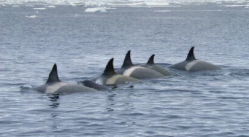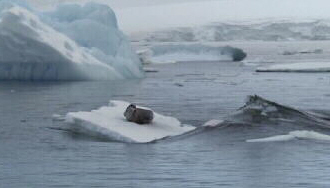Killer Whale Teamwork
The Remarkable Intelligence of an Orca Pod

Antarctica: Humans have long felt the lure of this mysterious world, yet it was only a hundred years ago that the first explorers walked inland and
were confronted by the highest, driest, coldest territory on Earth. Every year the continent is transformed when the ice that surrounds it disappears.
This melt halves the size of Antarctica.
It's the most spectacular seasonal change occurring anywhere on our planet. The remnants of the sea ice are occupied by sunbathing seals that have been here all winter.

Killer Whales Lurking
But, new arrivals are following the retreating ice edge, and they have come here to hunt. Killer whales: the oceans top predator. Killer's are
like wolves, for they will hunt animals that are far larger than themselves, but even smaller prey are a problem if you can't reach them.

Killer Whale Pod
The solution is teamwork. Swimming in perfect formation, they flick their tails in unison and create a wave that cracks the ice. They regroup and
assess the damage, a more powerful wave is needed. The ice floe is breaking up. Now, they are close enough to get a good look at the target. The seal
is a crab-eater, sharp-toothed and feisty, not their favourite. The rulers of the sea move on in search of easier quarry.



